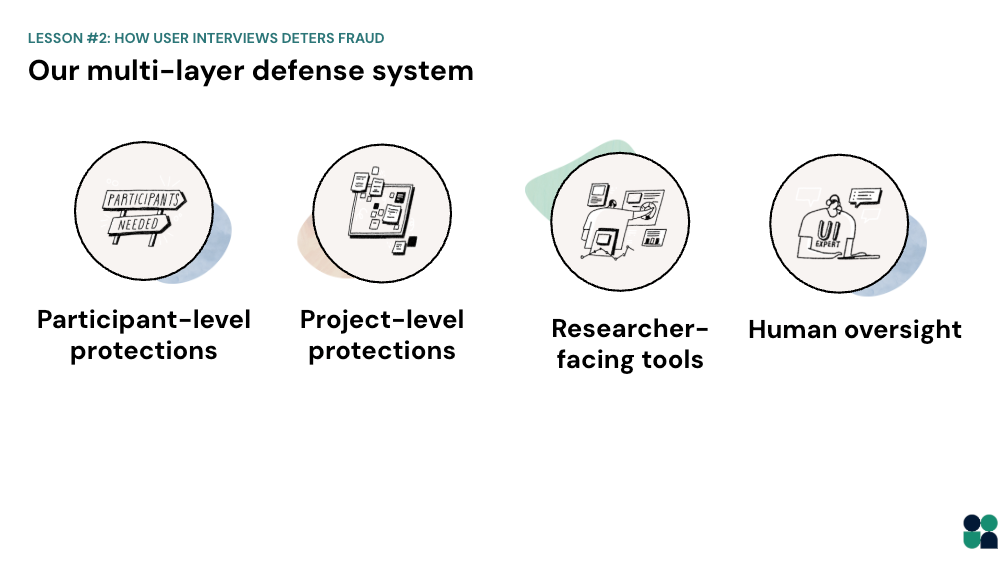

How User Interviews Deters Fraud
At User Interviews, we take fraud prevention seriously because the integrity of your research depends on it. Our fraud deterrence system doesn’t rely on a single line of defense—it’s a multi-layered, continuously evolving approach that combines machine learning, proactive safeguards, and human expertise. This multi-layered system allows us to catch over 95% of likely fraud before it ever reaches a researcher.
In this lesson, you’ll learn the ins and outs of our fraud prevention system, which is constantly working in the background to protect the integrity of your research.
📹 Prefer watching to reading? This content is available as both an article and a video. Watch our Senior Product Manager, David Prentice, take you through the content in the video below or keep reading to dive in!
How User Interviews deters fraud

Our multi-layered fraud defense system fights fraud from every angle, using a mix of:
- Participant-level protections
- Project-level protections
- Researcher-facing tools
- Human oversight
Next, I’ll go through a breakdown of each fraud detection tactic.
But before we get into it – You might notice we don’t disclose every element of our fraud detection process—and that’s intentional. Sharing too much about our systems could help bad actors learn how to evade them. By keeping certain details private, we preserve the integrity of our protections and maintain one of the most trusted participant networks in the industry.
Participant-level protections
Fraud prevention starts at the participant level. Our machine learning models analyze thousands of data points to flag suspicious accounts before they ever apply to a study. To identify anomalies, we use a combination of:
- Known fraud signals
- Verification checks
- AND Participant behavioral patterns
When an account raises red flags—like inconsistent demographics, mismatched IP data, or bot-like application patterns—it’s reviewed or removed before impacting your projects.
Project-level protections
Certain studies are more attractive to fraudsters—like those with high incentives or broad targeting criteria.
For these higher-risk projects, we apply additional safeguards, including stricter verification and routing applications to our most trusted participants. These adaptive systems ensure that even as fraud tactics change, your projects remain protected.
Researcher-facing tools
As part of our fraud protection system, we also empower you, the researcher, with built-in tools to make smarter participant decisions. You can quickly assess whether an applicant is genuine or not with features like:
- AI-use flags
- Participant quality indicators
- Social media verification
Video screening also adds another layer of confidence—letting you see and hear potential participants before confirming them. Together, these tools give you transparency and control over who joins your study.
Human oversight
Even the most advanced technology sometimes needs human judgment. Our project coordinators are trained to recognize subtle signs of fraud that automation might miss—such as suspicious communication patterns or inconsistencies in responses.
When something seems off, our PCs investigate, remove problematic accounts, and follow up to protect your research and our wider participant community.
Why we don’t share every detail
You might notice we don’t disclose every element of our fraud detection process—and that’s intentional. Sharing too much about our systems could help bad actors learn how to evade them. By keeping certain details private, we preserve the integrity of our protections and maintain one of the most trusted participant networks in the industry.
Thanks to our layered approach, more than 95% of likely fraud is caught before it ever reaches your study. And when suspicious behavior does slip through, our detection systems and support team act quickly to remove it, prevent recurrence, and refine our models for the future.
Download our Research Panel Report to learn more about the reliability, quality, and depth of our participant audience.
Keep learning


Practical Steps for Preventing Fraud




